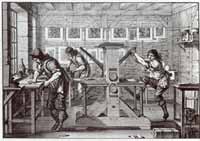
METHODS OF PRINTING
Antique prints have usually been made by passing an inked block against
paper. The blocks are made in one of three ways:
- by cutting away all the parts of a design which are not to be printed,
leaving the image proud of the surface of the block. This is called relief
printing.
- by cutting out the image itself leaving the non-printing parts proud
of the surface. This is called intaglio printing.
- by drawing the image directly onto the surface. This is called surface
printing.
Over the years different types of these three main methods have been developed
and are described below.
Relief printing
Woodcuts are the oldest form of relief printing, dating
from the early fifteenth century in the West. A design is drawn on a wood
block and the surface of the wood around the design is cut away. A roller
leaves ink on the lines and prints are made from the inked block. For
colour printing, a separate block is made for each colour.
Finer work - usually called wood engraving as opposed
to woodcuts - uses a block cut cross-grained rather than cut with the
grain, allowing the artist freedom to cut lines in any direction. Sometimes
soft metals instead of wood were used and this allowed the process of
etching out non-printing areas.
Intaglio printing
The main method of intaglio printing is engraving into
a metal plate, filling the resulting lines with ink and then pressing
the paper hard against the plate. In effect the paper is embossed into
the lines of ink. A number of different metals have been used by engravers,
with copper generally thought to produce the softest tone and be the easiest
to work. Engraving was a recognised profession from the sixteenth century
and engravers signed their work with their name and 'fecit' or 'he made'
in the right hand corner, crediting the artist in the left hand corner
with 'delinquit' or 'he designed'. In the eighteenth and nineteenth centuries
English engravers developed the mezzotint in which the
plate was first roughened so that it printed a deep rich black. Scrapers
were then used to produce light tones. Many of the finest prints of portraits
are mezzotints.
While mezzotint engravers produced prints of portraits and oil paintings,
another technique was needed to copy chalk and pastel drawings. Stipple
engraving allowed the outline of the design to be etched in with
fine dots made by needles and other, even smaller dots filled in the shaded
areas.
Various forms of etching provided greater variation of
tone. All methods begin by covering a metal plate with an acid-resistant
coating. The design is then scratched into this, exposing untreated metal.
The plate is then soaked in an acid solution which 'bites' the desired
image into the plate. In the eighteenth century, engravers developed the
aquatint for etching soft tonal areas on the plate, allowing
delicate tones and textures. The process involves fusing a rosin powder
to the plate to form a porous ground. When the plate is etched the acid
goes through the tiny pores in the ground, forming cavities in the metal
and it is these cavities which then hold the ink.

Surface printing
Drawing directly onto a stone or metal surface is known as lithography
and results in looser, freer images. A greasy crayon is used to make the
image. Because the grease attracts ink and repels water, the dampness
of the stone, before passing an ink roller over it, causes the ink to
stick to the greasy drawing, but not to the rest of the wet stone. Chromolithographs,
perfected in the late nineteenth century, are coloured pictures printed
from a stone and are distinctive for their clear bright colours.
© 2003 Russell Rare Prints
